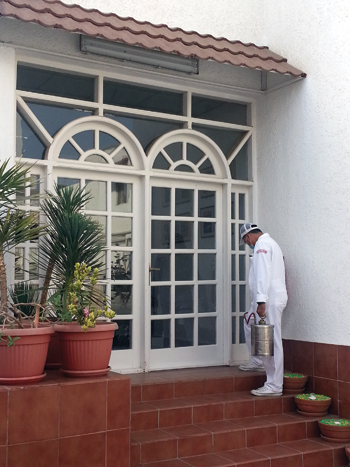Shown the door
MOHAMMAD ARIF HUSSAIN, entomologist at Masa, gives tips on how to reduce pest infestation in a timely, safe, effective manner
01 July 2014
INTERIOR spaces can become breeding grounds for pests that not only invade homes and cause structural damage as well as embarrassment when they emerge out of the woodwork, but also carry a host of diseases. It is, therefore, essential to find out where these pests hide and eliminate them from homes and commercial establishments.
The latest scientific research on integrated pest management (IPM) highlights the importance of shared responsibilities in environmental manipulation. Common interior pests are controlled by basic sanitation and good housekeeping strategies, with a reduction in the use of chemical controls.
When applying non-chemical pest control methods, the following guidelines should be followed:
• Exterior plants and shrubs should be trimmed back;
• Windows and doors should be closed, or screened when open;
• Storage areas in interiors should be reduced to limits areas where insects can nest; and
• All areas should be thoroughly vacuumed and dusted.
Chemical applications can be used after these guidelines are followed.
A number of pest problems start in building interiors where the carpets are not properly cleaned, leading to rapid infestation by ants, beetles, cockroaches, spiders and termites.
Cockroaches
These are insects of the order Blattodea and comprise roughly 3,500 species in six families. While it is difficult to eliminate them totally from all buildings, an existing infestation can be minimised by improving sanitation and ensuring these pests have no access to food. In addition, any leaking water pipes or faucets should be repaired and ventilation increased in areas where condensation is a problem.
Anobiid powderpost beetles
Most commonly, infestations of Anobiid powderpost beetles are found in structural timbers made of softwood, such as beams, sills, joists, studs, subflooring and plywood. In addition, these pests will infest hardwood furniture, wall panelling, window and door moulding, hardwood floors, and furniture. Woods such as maple, beech, poplar and pine are especially susceptible to attack. The beetles prefer to infest wood with a high moisture content in poorly ventilated areas in crawl spaces of houses, utility rooms and garages. Under favourable conditions, the infestation spreads into walls and other areas of the structure and while it develops slowly, wood can be reinfested year after year.
Subterranean termites
These are notorious timber-infesting insects and can damage and destroy internal wooden structures. Inadequate termite-proofing during preconstruction treatment allows them to penetrate buildings and start infestation. Successful termite management requires special skills including a working knowledge of building construction. In case of severe infestation, it is advisable to hire a professional pest control company to carry out inspections for conditions in and around the building that promote termite attack, such as excessive moisture or wood in contact with the soil and use an integrated programme to manage termites.
A termite control measure that can guarantee results is the creation of a chemical barrier around and below the building. This can be accomplished by several ways such as rodding, trenching, spraying, drilling, injecting and dusting. This soil treatment can be done in two stages:
• Pre-construction treatment, where the termiticide emulsion is applied during the construction stages of a building, starting from the foundation footing and the outside perimeter. This treatment depends on the technique used to construct the building as well as its structural composition. Termed as termite-proofing, this is a sure method that guarantees a complete chemical barrier.
• Post-construction treatment, which is carried out in existing buildings, mainly by drilling, injection and patching. Sometimes trenching and rodding is also done, the focus being on creating a continuous chemical barrier that will block termite entry points in foundations, expansion joints, the outside perimeter wall, and cracks in flooring/foundation walls and footings.
In addition, the interior design of some buildings may contribute to termite invasion such as the use of fine plaster in walls and ceilings for cornices and mouldings as well as coarse plaster or cement to create the stone-like cladding that extends to the ground in external wall surfaces. Attics and foundation areas should be kept well-ventilated and dry while screens should be used over vents, and other openings into the substructure should be sealed to block the entry of termites.
Masa
As a pioneer in pest control and management in Saudi Arabia, Masa Establishment for Pest Extermination, Maintenance and Contracting tackles pests through an IPM programme using a holistic approach. It has a portfolio of termiticides and insecticides selected on scientific basis.
The Jeddah-based company recently registered a new termiticide of the Neonicotinoid family, with the brand name Raslan Plus with the Saudi Food and Drug Authority (SFDA), the Saudi pesticide regulatory authority.
Raslan Plus, with the active ingredient Imidacloprid 30.5 per cent SC, is a systematic and contact insecticide, that is ecologically friendly and has low toxicity towards people and animals. It is odourless and creates a non-detectable treated zone that functions as a “killing field”, the effects of which may be transmissible to other termites and leads to contamination of the colony.
Backed by 34 years of experience, Masa offers professional and reliable services delivered through its team of highly skilled and well-equipped pest control technicians. All its services are tailored to individual properties and the needs of the business in question to ensure that the best possible results are attained.
- Taste of polynesia
- Serving the faithful
- Shown the door
- Designed for hospitality
- Plumbing without pain
- Panels go green
- Keeping it clean
- Tailor made
- What’s new
- In for the long haul



